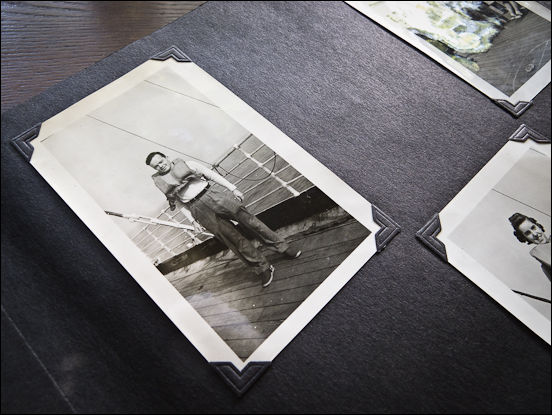Transient Memories
People have been taking snapshots of friends, family, and the places they visit since George Eastman first popularized photography with the first Kodak camera in 1888. In the 125 years since then a nearly uncountable number of photographs have been made. The pace of picture taking has only increased since the invention of digital photography and digital cameras becoming affordable to nearly everyone.
People upload 300 million photos every day to Facebook alone, according to a July 2012 story in USA Today. Sites like Facebook, Flickr, and Pinterest have become today’s photo albums. But will they be around in 75 years? Will our children and grandchildren be able to look back at these glimpses into our lives?

Snapshot of my dad, Byron Turner, on board ship en route to Europe, summer 1939.
My parents were both avid scrapbookers when they were in their twenties, the same age as our two boys are today. They both had cameras and they took pictures of their adventures.
How do I know? Their scrapbooks, with brittle and yellowing pages, still hold those photos. Most of them are pretty bad. Many did not get captioned so I don’t know who some of the people are. But, taken as a whole they show my parents taking off on adventures. My mom went with a couple of friends to the Chicago World’s Fair in 1933 and then to the New York World’s Fair in 1939. She recorded her time in college and in graduate school. My dad went to the World Conference of Christian Youth in Amsterdam in 1939, on the cusp of World War II.

Elizabeth Turner, 1940, print in scrapbook
We have the proverbial shoeboxes full of family snapshots from the years when our boys were young. Getting them into albums, with captions, is one of those “we’ll get to it someday” projects. But stored in the dark, those prints are going to last quite a while.
Digital photos are different. If you don’t make prints, you may never be able to look at them again. You can’t hold a CD up to the light and see the photos stored on it like you can with a strip of negatives or a box of slides. Digital photography is faster, there’s no waiting to see your pictures, and you can share them across the world in an instant. But they’re surprisingly fleeting and fragile. I’ve had several friends lament that they lost big batches of pictures when their computer hard drive failed, or they messed up the process of getting photos off their camera and onto their computer.

CD of photos, 2003
File formats change. Storage formats change. Do you remember 5¼ inch floppy drives? What about 3½ inch drives? Zip drives? Some computers today don’t even have CD or DVD drives any more. Everything is going to the cloud. Do you really want to trust your memories to Amazon, Google, or some other big web development company?
What should you do?
- Edit your photos and only keep the best ones. Get rid of the bad exposures, the bad framing, the “what was I shooting?” pictures.
- Make prints. Use a photo lab, or an inkjet printer with archival inks and photo paper.
- Add captions. Write names, places, and dates on the back in pencil, or in the margin. Your memory will fade faster than the photos.
- Store the prints in an album or reasonably archival box. A lady who calls herself the Practical Archivist Mike Manis has some tips.
Your children and grandchildren will thank you for taking the time to save some memories for them. They may thank you for having a professional family portrait made every few years, too. Your professional photographer, someone like me, will produce long-lasting images on top-quality paper that will stand the test of time.

